Co-written by Life As A Human regular authors George Burden and Joseph Frey, Wild Blue Yonder captures what was for them “the experience of a lifetime”. It was first published in the Halifax Sunday Herald on January 23rd, 2000.
We were on the tail of the MiG 29 as we hurtled through the sky. My pilot, Haligonian Capt. Al Clarke, followed closely as our prey tried every evasive manoeuvre, swerving back and forth, pushing us into our seats with half a ton of force. But it was all to no avail. Our radar locked onto the MiG’s airframe, confirming that one of our heat-seeking Sidewinder missiles would shortly slam into his fuselage.
Fortunately, this was only an exercise in air-to-air interception at Canadian Forces Base Bagotville, home to two of Canada’s five CF-18 fighter squadrons.
The MiG-29 was actually another CF-18 taking on the flight characteristics of the MiG in an exercise of aerial combat training that our pilots engage in regularly to keep their skills finely honed. Not that the Canadian Air Force has had shortage of real-life experience with the Persian Gulf War and more recently over Bosnia and Kosovo. Canadian CF-18’s and their pilots played very real roles in all three of these conflicts.
Upon arriving at Bagotville, I was given a two-hour lesson in emergency procedures and ejection seat training. Over an hour is spent reviewing the function of the ejector seat, actually a self-contained rocket unit that can blast its passenger 100 metres in the air, even from the ground. It is important that a passenger know how to safely unfasten the buckles and straps in case we need to bail out. I also spent some time suspended from a mock parachute and discovered that proper strap positioning was important for the male sex during descent.
Having been checked up, checked out and geared up, I was now ready to meet 433 squadron’s commanding officer, Lieutenant-Colonel Greg Matte, who was born in Middleton, N.S. He attended Royal Roads Military College and upon graduation won the Governor General’s gold medal for academic excellence. He then attended fighter school at CFB Cold Lake, home of Canada’s other two fighter squadrons, plus the Top Gun 410 training squadron. He has served in NATO actions over Kosovo, and since July 1998 has commanded 433 squadron.
Lt.-Col. Matte introduced me to my pilot, Capt. Al Clarke. Capt. Clarke grew up in Halifax and graduated from Halifax West in 1987. He completed a physics degree at Dalhousie under the ROTP program. Capt. Clarke also saw action in Kosovo. Although making up about three per cent of the aircraft in the NATO fleet in Kosovo, Canada headed up more than one in ten of the missions.
All fighter pilots are given a call sign, a sort of nickname that is used for ease of radio communication. Capt. Clarke sported the rather ominous moniker Psycho, but I found him to be a pleasant, soft-spoken Maritimer who went out of his way to ensure my safety and comfort during the flight.
Takeoff in a powerful F-18 is somewhat akin to blasting off in a rocket, its two engines providing over five tonnes of thrust, and we were soon airborne. As part of a squadron of four CF-18’s, our mission was to intercept three “MiG-29’s” that had encroached on our air space. The sky was sunlit, with several layers of clouds, as we cruised off in search of our foe.
It wasn’t too long before we sighted an enemy and were engaged in a dogfight. We performed high-speed turns, at times flying upside-down, violently manoeuvring back and forth trying desperately to stay behind our foe. Finally the HUD, or heads up display, showed we had a radar lock on the MiG, and it was officially downed. We were to destroy three of our opponents with only one hit scored against ourselves before the end of the day.
After flying over the Saguenay region of Quebec for more than an hour we were running low on fuel and received orders to head back to base. Flying in formation, each aircraft in turn hit the afterburners and peeled off. It had been just another day’s training for 433’s pilots, but the experience of a lifetime for me.
Meanwhile, Joe was flying with Canada’s Top Gun Squadron, the 410 Cougars, out of Cold Lake, Alta.
“Joe, roll the plane,” said Captain Shawn ‘Loaf’ Hartzell, a Top Gun instructor and South Shore, N.S. native. “What?” I responded, in total disbelief.
“Roll it, push the stick hard to the right,” was Hartzell’s response. At a speed of 430 knots at 14,000 feet of altitude, I slammed the stick to the right with some hesitation and watched the horizon turn from blue to green to blue again, a complete 360-degree roll.
“God, what a thrill.” I can’t believe I’m doing this.” I could feel the adrenaline surging through my body.
“Do it again,” Hartzell shouted over the headset. Without hesitating this time, I pushed the stick hard to the right and rolled the CF-18 for a second time.
My victory rolls ended the 90-minute live fire bombing runs over the Jimmy Lake Range, where we engaged in sixteen air to ground attacks using bombs, rockets and 20-mm cannon.
After separating from the rest of the four-plane strike package, Capt. Hartzell let me fly the CF-18 most of the way back to base. Nearing the base, Loaf took over control as we started to fly in close order formation with the other three CF-18’s flown by exchange pilots from Germany, Britain and Holland.
All of us had just experienced the most physically demanding form of military flying, the air to ground attack. In a period of just over an hour we had completed 16 live-fire ground attacks, consisting of 32 sharp manoeuvres with five Gs of force against our bodies with each turn. Each G is equivalent to the normal pull of gravity on our body, so five Gs makes you feel five times your normal weight.
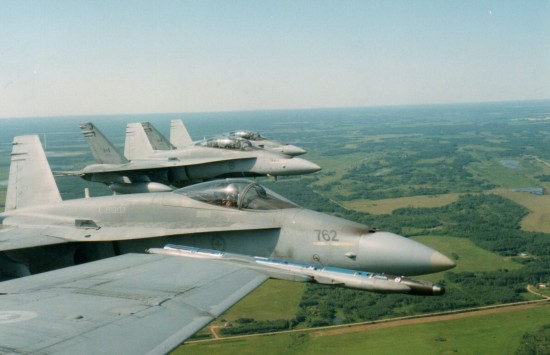
The other three CF-18A/Bs in the four plane strike package during the live-fire (bombs, missiles, 20 mm cannon) air-to-ground exercise at Jimmy Lake Range, Canadian Forces Base Cold Lake, Alberta. The pilots in the other aircraft were from Britain, Germany and the Netherlands.
Capt. Hartzell and the two most senior officers at 410 cautioned me against volunteering for the air to ground attacks because the strain on the body with so many manoeuvres in such a short period of time was extreme. Relishing the idea of experiencing the most physically demanding form of military flying, I went ahead anyway, thinking to myself, “No pain no gain.”
Little did I know that I was about to experience the most “gain” of my life.
Forget Tom Cruise in Top Gun, the reality of talking and moving in the cockpit of a supersonic fighter is a physical strain. It’s not unusual to lose ten pounds of body fluids during a flight. I was soaked right through my flight suit.
While pulling Gs, talking is difficult, speech is slower and your voice becomes deeper, as your neck muscles struggle to lift your head, which has just gone from weighing 30 pounds to 150 pounds. Your breathing is laboured. Turning to look over your left shoulder requires you to place your left hand on the pilot’s seat in front of you and your right hand on the right side of the cockpit so that you can push your body to the left and turn your head ever so slightly. Don’t turn your head as you start to pull Gs and climb at a steep angle, as I found out, or your fifth and sixth neck vertebrae will jam together. The pain is excruciating.
At this point, we have just climbed to 18,000 feet in what feels like a 90-degree ascent and are starting a steep angle attack in the inverted position against a ground target.
At the same time, Loaf is keeping an eye on the target reading data from the plane’s eighteen computers displayed on the heads up display, while making sure that the other three CF-18’s in our group are in proper attack formation. He surveys the ground and air for enemy anti-aircraft fire and hostile fighters. In his mind, Hartzell completes his calculations and sets priorities before releasing his weapons.
Both George and I watch and listen, during our respective flights, and are in awe of these pilots. How do they do it? They’re experiencing the same body strains that I am. How they continuously function under all this physiological and psychological pressure is amazing. It’s no wonder that only the best become fighter pilots.
The attack on the senses is incredible and so much happens to quickly. Even though I was in extreme pain during the fourth to eleventh attacks I’d do it again without hesitation.
George Burden is a physician who lives in Elmsdale. Joseph Frey is a freelance journalist base in Toronto.
Photo Credits
Captain Shawn Hartzell and Joseph Frey – by Joseph Frey – All Rights Reserved
The other three CF-18A’s … by Joseph Frey – All Rights Reserved
All other aerial photos – by George Burden – All Rights Reserved
Psycho and George Burden – by John Haynes – All Rights Reserved

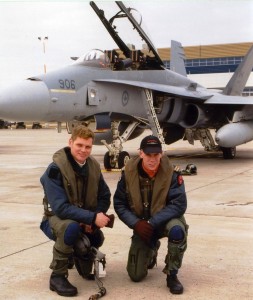
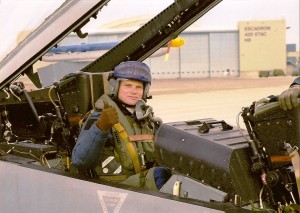
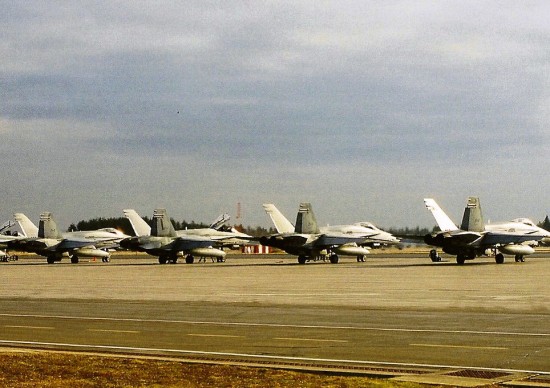
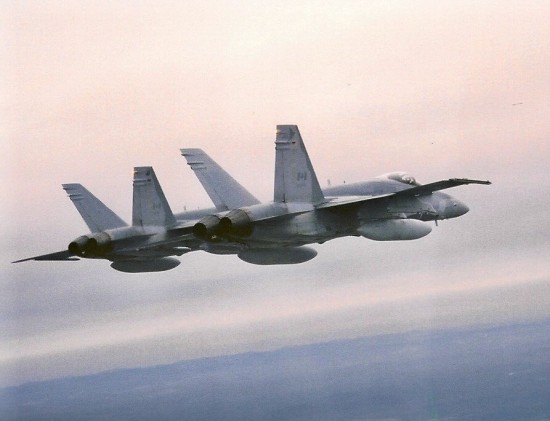
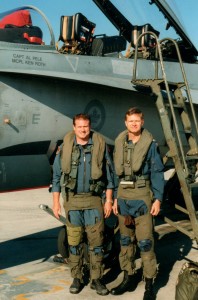
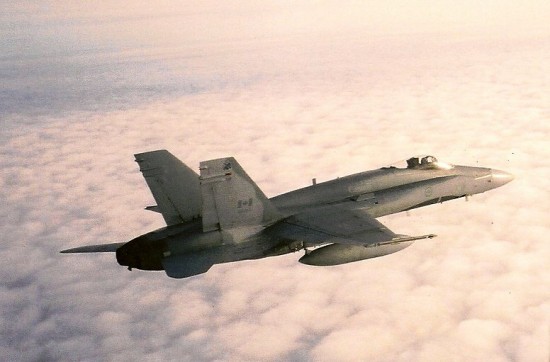

Please Share Your Thoughts - Leave A Comment!